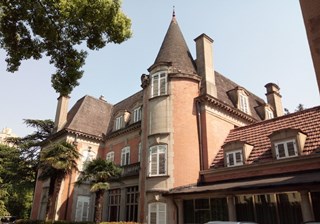- +86-13267351235
- info@globalstourtravels.com
Most people fall in love with the Marshal Residence at first sight.  Today, you can still hear people mention how this elegant building so finely reflected General George Marshall's graceful disposition, and how the building and the man were both equally unforgettable.
Today, you can still hear people mention how this elegant building so finely reflected General George Marshall's graceful disposition, and how the building and the man were both equally unforgettable.
On December 20, 1945, General Marshall took a specially chartered plane to Shanghai and moved into this house on 160 Taiyuan Lu.
Passing through the dark green iron gates and following the tortuous small path into the grounds, you will come upon this romantic French Renaissance style villa. Its simple clean lines and gentle brownish yellow and grey powder colors give this house a warm and comfortable feel. The villa architecture is graceful and elegant; its foursloped rooftops are covered in green tile, and five Napoleon helmet styled windows mark the meeting point between the roofing and the eaves. Directly under the eaves lies a succession of white brackets. The ground level porch is supported by three classical Greek Doric columns, and an open aired balcony sits on top.
In its former life, this was an independent garden villa belonging to the French colonials. In 1940 the property was sold to the son of Cen Chunxuan, the viceroy of Guangzhou and Guangxi under Wang Jingwei. After World War II the property was taken over as "illegal property", and in 1953 it was turned into a VIP Hotel used exclusively in entertaining foreign dignitaries. Today, the villa is part of Rui Jin Guest House and known as the Taiyuan Villa.
General Marshall's Mission to China: Anyone familiar with modem Chinese history is probably familiar with General Marshall's visit to China. On November 27, 1945 American president Harry Truman allowed Patrick Hurley to resign from his post as Ambassador to China. On December 20, he sent the army general chief of staff, George Catlett Marshall, as the president's special envoy to China to help mediate the military conflict between the communists and the nationalists, and help Chiang Kaishek speed up deployment of the Civil War. On the 22nd, Marshall arrived in Chongqing and on the 27th negotiations between the Communists and the Nationalists resumed. On January fifth 1946, an agreement was reached called the "Agreement On Ending Internal Military Conflict". Marshall eventually returned to the United States, frustrated by what he saw as a hopeless attempt to compromise between both parties.
Address
The Marshall residence is located at 160 Taiyuan Lu (originally called Route Rene Delastre). You can get here by walking from Huangpi Nanlu or Huaihai Zhonglu. You can take bus lines 41, 42, 45, 96, 104, 128, 301, 327, and 864. Be sure to get off the bus at Yongjia Lu or at Jianguo Xilu and walk over.
Special Note
The Tang Enbo Residence is located at 200 Taiyuan Lu, and its architectural style is very similar to that of the Marshall Residence. Tang Enbo was a highlevel Kuomintang officer before China's liberation. Although it is not frequently open for tours, if time allows, you can still have a look around the building grounds. The Marshall Residence has two doors. The main entrance is labeled with the words "Taiyuan Villa", the other is labeled only with a street number. If the guard at the door asks what you are doing, you can say that you are going in to have a cup of coffee. More often than not, no one will prevent you from going in. The residence is about one kilometer away from Rui Jin Guest House and takes about 20 minutes to walk over. Along the way you will pass by Yongjia Lu. This road has a few residential areas you can visit, and some have architecture worth seeing. Most of it is British-style residential architecture.